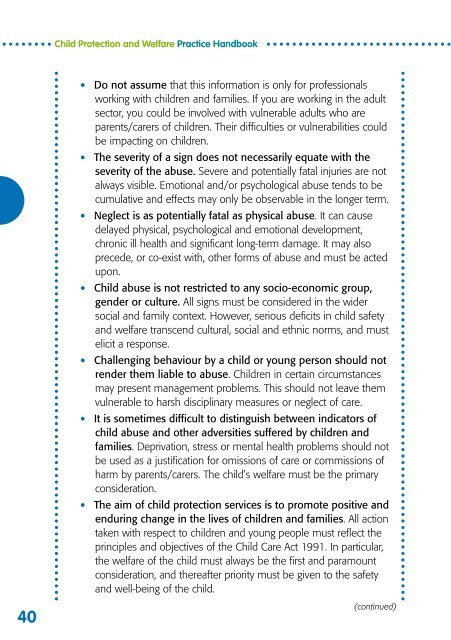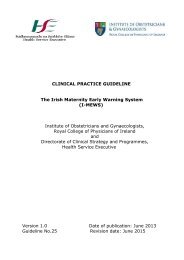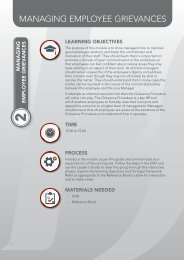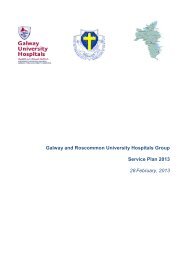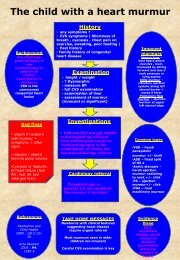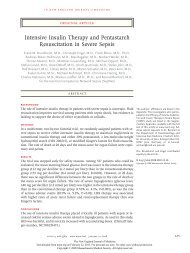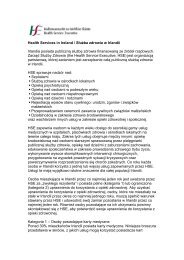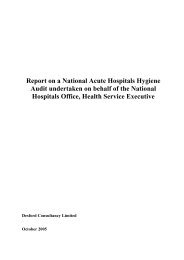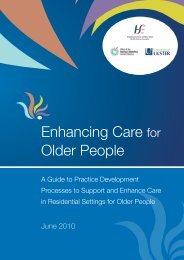Child Protection and Welfare Practice Handbook - Health Service ...
Child Protection and Welfare Practice Handbook - Health Service ...
Child Protection and Welfare Practice Handbook - Health Service ...
Create successful ePaper yourself
Turn your PDF publications into a flip-book with our unique Google optimized e-Paper software.
40<br />
<strong>Child</strong> <strong>Protection</strong> <strong>and</strong> <strong>Welfare</strong> <strong>Practice</strong> H<strong>and</strong>book<br />
• Do not assume that this information is only for professionals<br />
working with children <strong>and</strong> families. If you are working in the adult<br />
sector, you could be involved with vulnerable adults who are<br />
parents/carers of children. Their difficulties or vulnerabilities could<br />
be impacting on children.<br />
• The severity of a sign does not necessarily equate with the<br />
severity of the abuse. Severe <strong>and</strong> potentially fatal injuries are not<br />
always visible. Emotional <strong>and</strong>/or psychological abuse tends to be<br />
cumulative <strong>and</strong> effects may only be observable in the longer term.<br />
• Neglect is as potentially fatal as physical abuse.<br />
It can cause<br />
delayed physical, psychological <strong>and</strong> emotional development,<br />
chronic ill health <strong>and</strong> significant long-term damage. It may also<br />
precede, or co-exist with, other forms of abuse <strong>and</strong> must be acted<br />
upon.<br />
• <strong>Child</strong> abuse is not restricted to any socio-economic group,<br />
gender or culture. All signs must be considered in the wider<br />
social <strong>and</strong> family context. However, serious deficits in child safety<br />
<strong>and</strong> welfare transcend cultural, social <strong>and</strong> ethnic norms, <strong>and</strong> must<br />
elicit a response.<br />
• Challenging behaviour by a child or young person should not<br />
render them liable to abuse. <strong>Child</strong>ren in certain circumstances<br />
may present management problems. This should not leave them<br />
vulnerable to harsh disciplinary measures or neglect of care.<br />
• It is sometimes difficult to distinguish between indicators of<br />
child abuse <strong>and</strong> other adversities suffered by children <strong>and</strong><br />
families. Deprivation, stress or mental health problems should not<br />
be used as a justification for omissions of care or commissions of<br />
harm by parents/carers. The child’s welfare must be the primary<br />
consideration.<br />
• The aim of child protection services is to promote positive <strong>and</strong><br />
enduring change in the lives of children <strong>and</strong> families. All action<br />
taken with respect to children <strong>and</strong> young people must reflect the<br />
principles <strong>and</strong> objectives of the <strong>Child</strong> Care Act 1991. In particular,<br />
the welfare of the child must always be the first <strong>and</strong> paramount<br />
consideration, <strong>and</strong> thereafter priority must be given to the safety<br />
<strong>and</strong> well-being of the child.<br />
(continued)


